Here, you find my whole video series about Real Analysis in the correct order and you can choose between the bright and dark version of the videos. I also help you with some text and explanations around the videos. If you want to test your knowledge, please use the corresponding quiz and exercise sheet after watching the video. Moreover, you can also consult the PDF version of the video if needed. In the case you have any questions about the topic, you can contact me or use the community discussion in Mattermost and ask anything. You can also find a quick summary of the course. However, without further ado let’s start:
Part 1 - Introduction
Real analysis is a video series I started for everyone who is interested in calculus with the real numbers. It is needed for a lot of other topics in mathematics and the foundation of every new career in mathematics or in fields that need mathematics as a tool:

Content of the video:
00:00 Introduction
00:27 Topic of real analysis
01:31 Requirements
02:05 Axioms of the real numbers
03:54 Credits
With this you now know the topics that we will discuss in this series. Some important bullet points are limits, continuity, derivatives and integrals. In order to describe these things, we need a good understanding of the real numbers. They form the foundation of a real analysis course. Now, in the next video let us discuss sequences.
Part 2 - Sequences and Limits
The notion of a sequence is fundamental in a lot of mathematical topics. In a real analysis course, we need sequences of real numbers, which you can visualise as an infinite list of numbers:

Content of the video:
00:00 Introduction
00:15 Definition of a sequence
01:50 Examples
06:06 Definition of convergence and divergence
08:55 Example and Archimedean property
11:56 Credits
Part 3 - Bounded Sequences and Unique Limits
Now you know what a convergent sequence is. However, not all sequences are convergent. A weaker property is the notion of a bounded sequence.
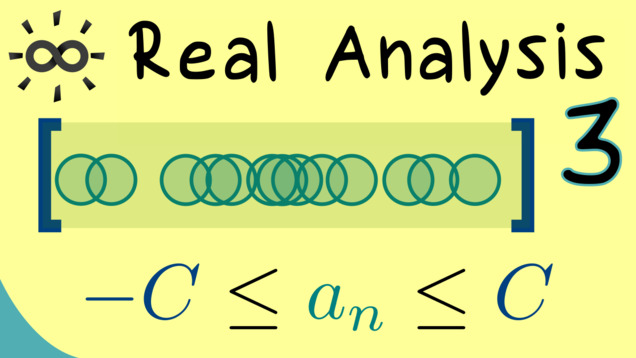
Content of the video:
00:00 Intro
00:15 An example for showing that a sequence is divergent
03:41 Definition of a bounded sequence
04:36 A convergent sequence is also bounded
06:09 The limit of a convergent sequence is uniquely given
08:59 Outro
Part 4 - Theorem on Limits
At this point you know a lot about sequences, especially about convergent sequences. Since we do not want to work every time with the definition, using epsilons and so on, we prove the following limit theorems:
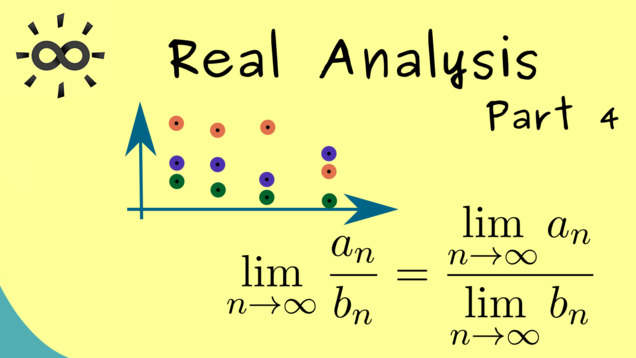
Content of the video:
00:00 Intro
00:18 Limit of a sequence
01:16 Theorem on limits
03:48 Example
06:22 Outro
Part 5 - Sandwich Theorem
Another important property we will use a lot for showing that a sequence is convergent and also for calculating its limit is the sandwich theorem:

Content of the video:
00:00 Intro
00:10 Limit theorems
00:50 Monotonicity of the limit
01:45 Sandwich Theorem
02:33 Proof of the Sandwich Theorem
05:30 Example
07:48 Outro
Part 6 - Supremum and Infimum
Now, we go back to general subsets of the real numbers and talk about some important concepts, supremum and infimum of sets:

Content of the video:
00:00 Intro
00:14 Intervals
01:31 Maximum and upper bounds
02:19 Minimum and lower bounds
02:44 Definition of bounds
04:14 Examples
05:43 Definition Supremum and Infimum
08:40 Credits
Part 7 - Cauchy Sequences and Completeness
Let us talk about Cauchy sequences. These special sequences and the concept of completeness are deeply connected. So here we need to recall the completeness axiom of the real numbers. Moreover, we also introduce the concept of Dedekind completeness, which uses the supremum of subsets.

Content of the video:
00:00 Intro
00:14 Convergent sequences
00:54 Different property of a sequence
02:09 Definition Cauchy sequence
02:16 Connection to convergent sequences
03:14 Dedekind completeness
03:47 Sketch of proof
07:35 Application for monotonic sequences
08:44 Credits
Part 8 - Example Calculation
Very good! It is time to explicitly calculate with an example. Also it is a good time to introduce, the very famous, Euler’s number.
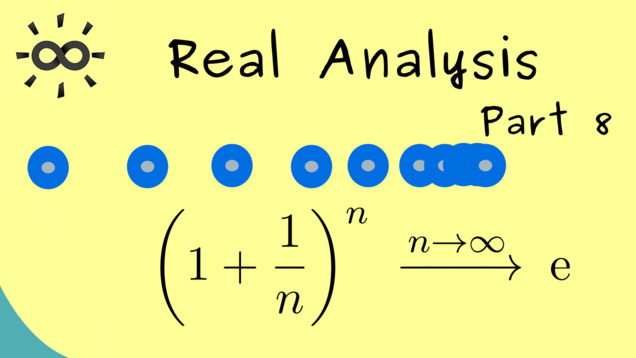
Content of the video:
00:00 Intro
00:21 Recalling the monotone convergence criterion
00:55 Introducing the example
01:21 Proving monotonicity
04:49 Proving bounded from above
08:55 End result of the example
09:46 Credits
Part 9 - Subsequences and Accumulation Values
Another important topic in Real Analysis and for sequences are so-called accumulation values.

Content of the video:
00:00 Intro
00:13 Definition of subsequences
01:40 Example
03:26 General fact about subsequences
04:00 Example with a divergent sequence
05:04 Definition accumulation value
06:49 Alternative definition of accumulation values
07:47 Credits
Part 10 - Bolzano-Weierstrass Theorem
By knowing what accumulation values for sequences actually are, we can discuss a famous and important fact in this field: the Bolzano-Weierstrass theorem.

Content of the video:
00:00 Intro
00:20 Bolzano-Weierstrass theorem
01:13 Proof
05:42 Credits
Part 11 - Limit Superior and Limit Inferior
There are two special accumulation values for a sequence: the limit superior and limit inferior.

Content of the video:
00:00 Intro
00:20 Example
02:07 Improper accumulation value
03:34 Definition limit superior and limit inferior
04:29 Why do we use these names and notations?
06:45 Fact
08:24 Credits
Part 12 - Examples for Limit Superior and Limit Inferior
Let us do some examples and calculations rules for the limit superior and limit inferior:
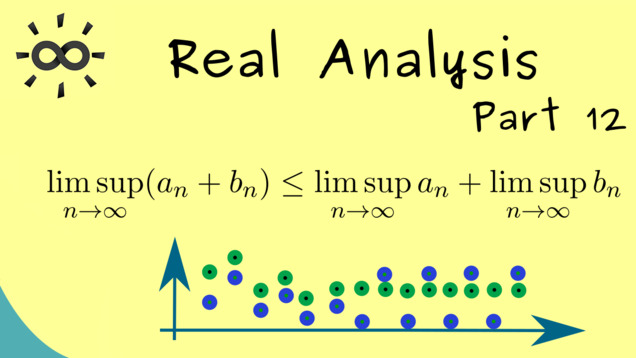
Content of the video:
00:00 Intro
00:37 Example
01:31 Properties of lim sup and lim inf
03:00 Properties for combining 2 sequences
04:53 Example summation of 2 sequences
06:00 Example product of 2 sequences
06:57 Credits
Part 13 - Open, Closed and Compact Sets
Now, we are ready to talk about some important notions for subsets of the real numbers. Namely, we discuss what open, closed, and compact sets actually are.

Content of the video:
00:00 Intro
00:14 Recalling (epsilon-)neighbourhoods
01:33 Example: neighbourhoods
02:43 Definition open sets
04:00 Definition closed set
04:43 Examples
06:11 Criterion for checking closeness with the help of sequences
06:44 Example for the criterion
07:40 Definition compact sets
08:58 Credits
Part 14 - Heine-Borel Theorem
Since we now know what compact sets in the real numbers are, we can ask what are necessary and sufficient conditions for knowing that a given set is compact. Indeed, for subsets of the real number line, the famous Heine-Borel theorem gives us a nice description:

Content of the video:
0:00 Introduction
0:20 Sequentially compact set
1:07 Empty set is compact
1:17 {5} is compact
1:50 R is not compact
2:10 Proof: [a,b] is compact
3:15 Heine-Borel theorem statement
3:58 Proof of Heine-Borel theorem
Part 15 - Series - Introduction
Let us start with the next big topic: series. One can see them as special sequences but we will see that they occur often in different problems.

Content of the video:
00:00 Intro
00:19 Introducing series
01:07 Example of a series
02:46 Definition series
04:18 Rewriting the previous example
05:04 Another example
05:48 Credits
Part 16 - Geometric Series and Harmonic Series
Two important examples for series are discussed in the next video: geometric series and harmonic series:

Content of the video:
00:00 Intro
00:14 Recalling series
00:42 Geometric series
04:05 Harmonic series
09:05 Credits
Part 17 - Cauchy Criterion
In the next videos we will talk about a lot of criteria we can use to test for convergence of a given series. We start with the simplest one: the Cauchy criterion:

Content of the video:
00:00 Intro
00:36 Properties of series
02:20 Cauchy Criterion
03:46 Proof
05:29 Example
07:15 Conclusion
08:47 Credits
Part 18 - Leibniz Criterion
The next criterion we will talk about is very useful for alternating series and called the Leibniz criterion:
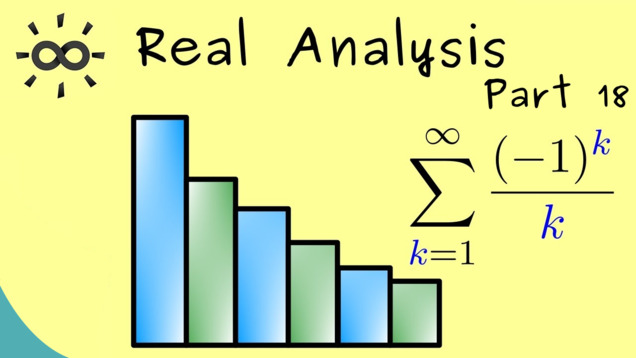
Content of the video:
00:00 Intro
00:18 Recalling the harmonic series
01:24 Leibniz Criterion
03:07 Proof
07:52 Example
08:35 Credits
Part 19 - Comparison Test
Since we already know some convergent and divergent series, it might be useful to use them to decide if a given series is also convergent or divergent. This is known as the comparison test. One distinguish between the majorant criterion and the minorant criterion, depending from which side one looks at the series and if one wants to show convergence or divergence.

Content of the video:
00:00 Intro
00:21 Absolutely convergent
00:47 Absolutely convergent implies convergent
02:06 Implication doesn’t work in the other direction
02:45 Majorant criterion
04:16 Proof of majorant criterion
05:31 Minorant criterion
06:30 Example for the minorant criterion
07:44 Credits
Part 20 - Ratio and Root Test
By using the geometric series, the majorant criterion immediately leads to two very helpful tests: root test and ratio test.

Content of the video:
00:00 Intro
00:50 Recalling the geometric series
01:26 Proposition
02:33 Ratio test
03:43 Proof of the ratio test
05:14 Example using the ratio test
07:01 Root test
07:37 Proof of the root test
08:21 Example using the root test
09:15 Root criterion (limit form)
10:58 Credits
Part 21 - Reordering for Series
A natural question when dealing with a series is if one can reorder it without changing the value like one knows happens for ordinary sums. However, for series a reordering can change the limit:

Content of the video:
00:00 Intro
00:17 Meaning of reordering of series
01:13 Example: Reordering can change the value
02:32 2nd Example with a convergent series
04:58 Definition Reordering
06:10 Theorem for abs. convergent series
06:39 Proof of the Theorem
12:22 Credits
Part 22 - Cauchy Product
Let’s close the chapter about series with an important operation: the Cauchy product:

Content of the video:
00:00 Intro
00:38 Looking at finite sums
02:30 Definition Cauchy Product
04:07 Theorem about abs. convergence
04:49 Example for the theorem
07:51 Credits
Part 23 - Sequence of Functions
The next chapter will deal with continuous functions. However first, we need to define some notions for sequences of functions:
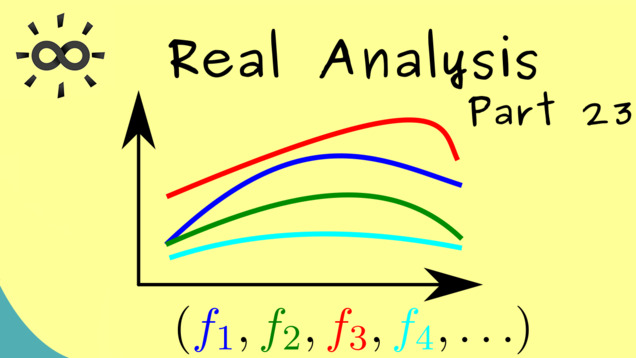
Content of the video:
00:00 Intro
00:19 Definition function
01:06 Continuous function
02:20 Definition bounded function
03:36 Definition sequence of functions
05:57 Credits
Part 24 - Pointwise Convergence
The notion of pointwise convergence for a sequence of functions is a very natural one:

Content of the video:
00:00 Intro
00:33 Pointwise convergence
02:03 1st Example
03:20 2nd Example
06:40 3rd Example
07:43 Credits
Part 25 - Uniform Convergence
Also the notion of uniform convergence for a sequence of functions is important and can be expressed with the help of the supremum norm:

Content of the video:
00:00 Intro
00:44 Uniform convergence
02:52 Measuring distance between functions
04:30 Uniform convergence using supremum norm
05:06 Example
06:28 Uniform convergence is stronger than pointwise convergence
07:30 Credits
If you want to learn more how to show uniform convergence for special examples, you can check out the supplementary video about the Weierstrass M-Test.
Part 26 - Limits of Functionss
Now let us go to the definition of continuity. For this, we will need the notion of limits for functions:

Content of the video:
00:00 Intro
00:59 Definition
05:50 1st Example
06:29 2nd Example (Polynomial)
08:12 Credits
Part 27 - Continuity and Examples
The definition of continuity can be easily formulated with sequences or just which the limit notion from above. After having this, we can look at some examples:

Content of the video:
00:00 Intro
00:18 Definition Continuity
01:22 Special case (holes in the domain of definition)
02:56 Extended definition of continuity
03:48 Examples
09:28 Credits
Part 28 - Epsilon-Delta Definition
Now we can finally talk about the Epsilon-Delta definition of continuity.

Content of the video:
00:00 Intro
00:40 Epsilon-Delta criterion
04:32 Proof
08:28 Credits
Part 29 - Combination of Continuous Functions
Continuous functions have a lot of nice properties. We start with the question what happens when we combine different functions, like adding, multiplication, and the composition.

Content of the video:
00:00 Intro
00:14 Recalling continuity
01:25 Combining 2 continuous functions
03:07 Composition of functions
05:55 Proof for composition of functions
07:27 Credits
Part 30 - Continuous Images of Compact Sets are Compact
Next nice property: continuous images of compact sets are always compact.

Content of the video:
00:00 Intro
00:14 A special property of continuous functions
01:09 Theorem about images of compact sets
03:25 Proof of the Theorem
06:33 Credits
Part 31 - Uniform Limits of Continuous Functions are Continuous
Uniform limits of continuous functions have to be continuous as well:

Content of the video:
00:00 Intro
00:14 Uniform convergence for sequence of functions
01:09 Theorem for uniform limit of continuous functions
02:18 Proof of the Theorem
07:41 Credits
Part 32 - Intermediate Value Theorem
The intermediate value theorem, finally!

Content of the video:
00:00 Intro
00:14 Introducing the Intermediate Value Theorem
01:26 Definition Intermediate Value Theorem
02:29 Corollary
02:56 Proof of the Intermediate Value Theorem
08:16 Credits
Part 33 - Some Continuous Functions
Now, at this point, we really should look at important examples. The exponential function, we already have discussed a little bit. However, it turns out that there is an inverse, we call the logarithm function and we denote it by $ \log $. Please note that this is the natural logarithm function which one often sees written as $ \ln $ as well. Moreover, in this video, we can generalise the whole concept and find so-called power series:

Content of the video:
00:00 Intro
00:25 Exponential Function
03:27 Logarithm Function
05:00 Polynomials
05:33 Power Series
08:49 Credits
Part 34 - Differentiability
After we have looked at some examples, we are now ready to talk about differentiability. This means we will finally define the derivative:

Part 35 - Properties for Derivatives
We can prove the sum and product rule for differentiable functions:

Part 36 - Chain Rule
Also very important is the so-called chain rule when we deal with compositions of differentiable functions:

Part 37 - Uniform Convergence for Differentiable Functions
In the following videos, we will look at a lot of examples, in particular ones that are given by power series. However, for them, differentiability is not clear at all. To show this property, we have to talk about what the uniform convergence of functions actually conserves. The next video is about such a nice theorem.

Part 38 - Examples of Derivatives and Power Series
Let’s apply all our knowledge about derivatives to get important examples:

Part 39 -Derivatives of Inverse Functions
Now we want to calculate the derivative of the logarithm function. Since it is the inverse of the exponential function, we should try to find an inversion formula for derivatives. This is indeed possible:

Part 40 - Local Extreme and Rolle’s Theorem
In this an in the next video we will talk about the famous Mean Value Theorem. As a groundwork, we have to proof Rolle’s theorem first:
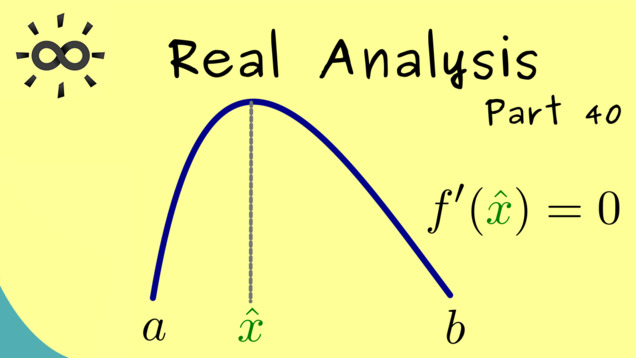
Part 41 - Mean Value Theorem
Now, we are ready to formulate and prove the Mean Value Theorem first:

Part 42 - L’Hospital’s Rule
Next, let us apply our knowledge to prove the popular Theorem of l’Hospital and apply to examples:

Part 43 - Other L’Hospital’s Rules
Now, let’s formulate a generalisation for l’Hospital’s theorem by considering four different cases that can occur in applications:

Part 44 - Higher Derivatives
The next important topic will be about Taylor’s formula. In order to understand this, we need to talk about higher derivatives first:
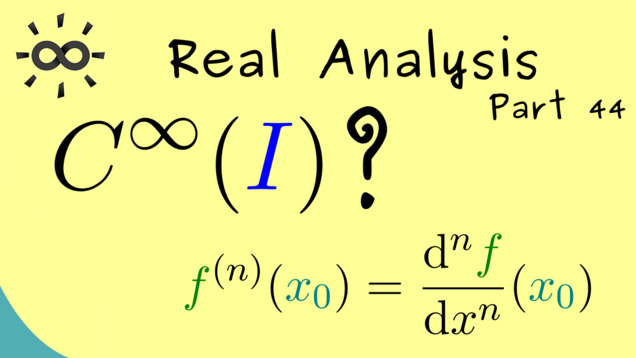
Part 45 - Taylor’s Theorem
Now we finally discuss Taylor’s Theorem:

Part 46 - Application for Taylor’s Theorem
Let us immediately look at an application for Taylor’s Theorem by approximating a value of complicated function:

Part 47 - Proof of Taylor’s Theorem
Now we can prove Taylor’s Theorem by using the generalised mean value theorem from above:

Part 48 - Riemann Integral - Partitions
Finally, we start with the Riemann integral by using the definition of a partition and step function:

Part 49 - Riemann Integral for Step Functions
Now we can define the Riemann integral for step functions:

Part 50 - Properties of the Riemann Integral for Step Functions
Let us show important properties of the Riemann integral for step functions:

Part 51 - Riemann Integral - Definition
Now we are finally ready to define the Riemann integral for bounded functions:

Part 52 - Riemann Integral - Examples
Let us look at examples for calculating the Riemann integral using the approximation by step functions:

Part 53 - Riemann Integral - Properties
Now we can talk about some important properties of the Riemann integral for bounded functions:

Part 54 - First Fundamental Theorem of Calculus
Finally, we talk about one of the main results in this course: the so-called First Fundamental Theorem of Calculus:

Part 55 - Second Fundamental Theorem of Calculus
And also we should talk about the Second Fundamental Theorem of Calculus:
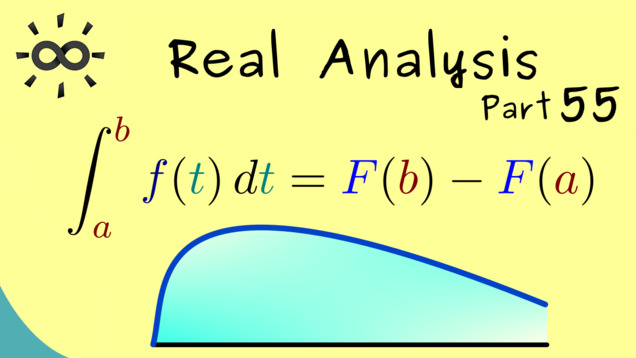
Part 56 - Proof of the Fundamental Theorem of Calculus
Now let us prove the Fundamental Theorem of Calculus by using the Mean Value Theorem of Integration:

Part 57 - Integration by Substitution
Next, we will discuss some integration rules. We start with substitution.
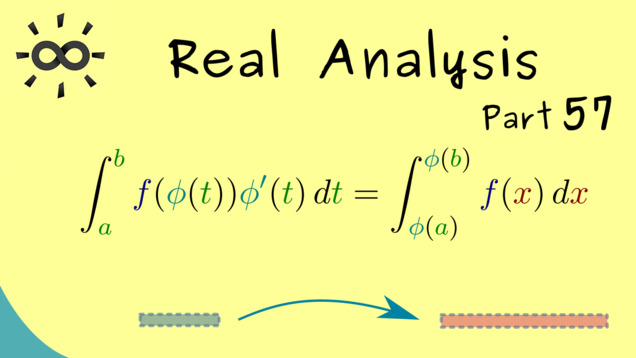
Part 58 - Integration by Parts
A similar rule that can simplify integrals is given by integration by parts. It can help you when you have an integral of a product of two functions.
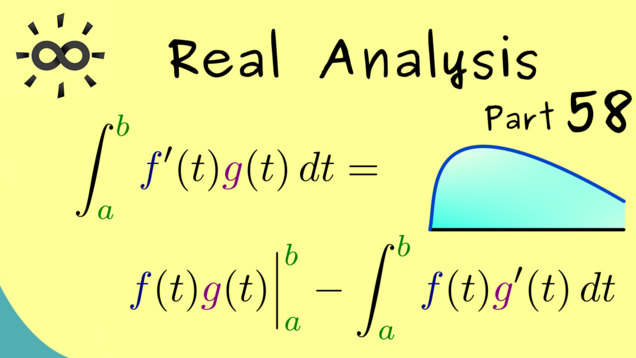
Part 59 - Integration by Partial Fraction Decomposition
The next thing in our toolbox for integration can help you when you need to integrate rational functions. What we will need is the so-called partial fraction decomposition. After doing this, finding the antiderivatives is not hard at all.

Part 60 - Integrals on Unbounded Domains
The next part is about improper Riemann integrals. In particular, we will consider integration on unbounded domains. This is something the ordinary Riemann integral couldn’t cover by definition. However, we can extend this definition when we combine it with a usual limit of real numbers.
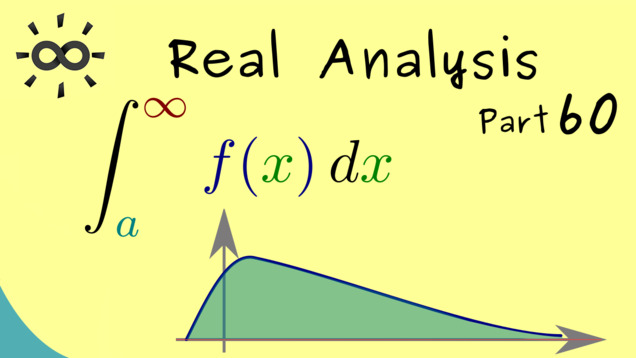
Part 61 - Comparison Test for Integrals
You might have already recognised that these improper Riemann integrals are related to infinite series. Indeed, we find a similar comparison test for integrals as well:

Part 62 - Integral Test for Series
Moreover, integral can be used to show convergence of series and vice versa. However, often integrals are easier to calculate because of the fundamental theorem of calculus. Therefore, we find the integral test of convergence for series:

Part 63 - Improper Riemann Integrals of Unbounded Functions
Now, we can also extend the notion of an improper Riemann integral for functions that have holes in the domain of definition. More precisely, we can extend the notion of the Riemann integral to unbounded functions:

Part 64 - Cauchy Principal Value
Now, finally, we tackle the last video in this series. Let us close the topic of improper Riemann integrals and also talk about a generalisation of them: the so-called Cauchy principal value:
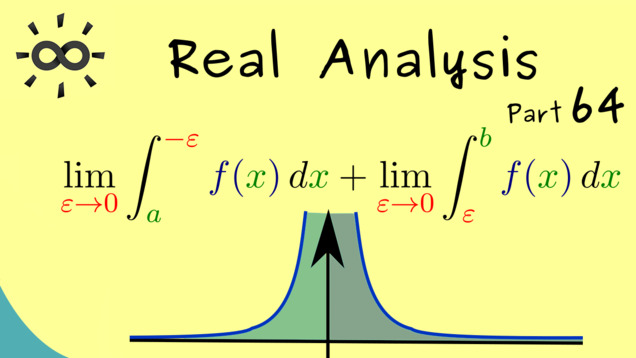
Connections to other courses
Summary of the course Real Analysis
- You can download the whole PDF here and the whole dark PDF.
- You can download the whole printable PDF here.
- Test your knowledge in a full quiz.
- See more exercises and solutions for the topics.
- Ask your questions in the community forum about Real Analysis
Ad-free version available:
Click to watch the series on Vimeo.